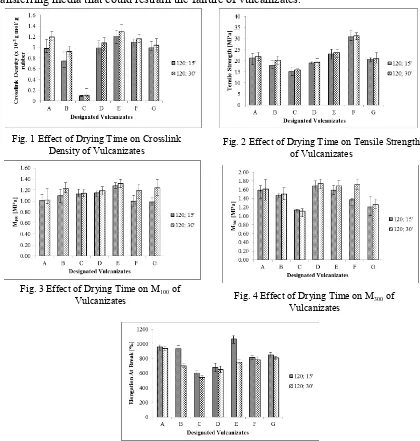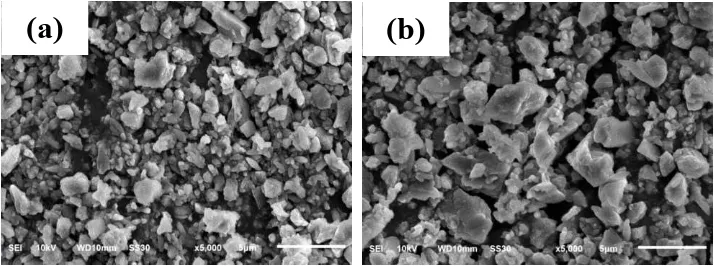Effect of Drying Time on Mechanical Properties of Natural Rubber
Products Filled with Modified Kaolin Prepared From Latex Dipping
Hamidah Harahap
1, a*, Elmer Surya
2,b, Indra Surya
3,c, Baharin Azahari
4,d,
Hanafi Ismail
5,e1,2,3
Department of Chemical Engineering, University of Sumatera Utara, Jalan Almamater, Kampus USU Medan 20155, North Sumatra, Indonesia
4
School of Industrial Technology, Universiti Sains Malaysia, 11800 Minden, Penang, Malaysia
5
School of Materials and Mineral Resources Engineering, Universiti Sains Malaysia, 14300 Nibong Tebal, Penang, Malaysia
a
[email protected], [email protected]
c
[email protected], [email protected], [email protected]
Keywords: Kaolin, Alkanolamide, Natural Rubber Latex, Drying Time, Dipping
Abstract. Alkanolamide-modifed kaolin was added into natural rubber latex (NRL) pre-vulcanization system at 70oC and the products were formed into films by coagulant dipping method. The dipped films then were dried at 120oC for 15 and 30 min. The effect of drying time on properties of NRL films such as crosslink density, tensile strength, tensile modulus, and elongation at break was observed in this study. Results showed that longer drying time improved the properties of NRL films due to the additional formation of crosslink process in the NRL films. The longer drying time swelled the particles more in matrix as confirmed by Scanning Electron Microscopy (SEM) micrograph.
Introduction
Natural rubber latex (NRL) is a polymer latice of milky colloidal suspension that contains 1,4-cis polyisoprene dispersed in water and preserved with ammonia. NRL can be formed into several products such as rubber gloves, condoms, balloons, babies’ feeder teats and soothers, seamless footwear, seamless football bladders, and catheters through latex dipping method [1]. Latex dipping is the simplest and conventional method to obtain rubber products. It involves plate formers that were dipped into pre-vulcanized natural rubber latex (PVNRL) formulation then followed by drying to secure the final products.
NRL can be incorporated with fillers to achieve products with improved mechanical properties however several researches in recent years was focused on modification of fillers before it was added into NRL matrix. This is due to different polarity between unmodified fillers with the matrix, thus may cause poor dispersion of fillers in latex film [2]. To overcome this problem, the fillers can be modified organically in order to compatibilize the matrix and the fillers [3]. Kaolin as one of mineral clays can be considered to be used as fillers for latex. It is cheap, abundant, and has ion exchange capability from exposed hydroxyls of kaolin surface [4]. Thus, kaolin has possibility to be modified organically such as the intercalation with rubber seed oil and tea seed oil as reported by Mgbemena et al. [5]. Moreover, Yahaya et al. and Malicka-Soczka et al. in their study also used
organo modified kaolin as fillers in natural rubber (NR) matrix and the products showed improved mechanical properties [6-7]. The other studies also reported that incorporation of modified fillers into the rubber matrix improves the mechanical properties of the products [8-10].
In this study, the kaolin used as fillers in NRL matrix was modified by alkanolamide, an oleochemicals derived from derived from Refinery Bleach Deodorant Palm Stearin (RBDPS). The alkanolamide is expected to intercalate the kaolin surface so that the latex film has good filler dispersion. The objective of this study is to study the effect of drying time of dipped-latex on its properties such as crosslink density, tensile strength, tensile modulus and elongation at break.
Experimental Procedure
The fillers with amount of 10 pphr (part per hundred rubber) were prepared by dispersing 15 wt% (weight percent) kaolin in the ball mill which consists of water and alkanolamide. The alkanolamide used was 0-2.5 wt%. Table 1 provides the dispersion system of pre-vulcanized latex with the fillers and designated by the codes.
The formulation for NRL compounding is shown in Table 2. The pre-vulcanization took 12 min at 70oC. For each 3 min, 3 drops of mixing system were taken and tested by 5 drops of chloroform for each 3 min to observe whether the system has reached chloroform number 3 (the latex has form of non-tacky agglomerates).
After it had been pre-vulcanized, the mixture was opened up for 24 h to allow the bubbles escaped from the surface. Meanwhile, the plate formers for dipping system (125 mm x 125 mm x 0.5 mm) were prepared by washing it with sodium hydroxide and acetic acid, coagulating it with calcium nitrate to release the impurities of the plates and drying it in the oven. Then the dried plates were dipped in the latex system and the dwell time was set at 5 sec. Finally, the film plate formers were dried in oven at 120oC for 15 and 30 min.
Table 1 Prevulcanized Latex System with Fillers and Designated Codes
Samples Kaolin Alkanolamide Water Codes
NRL 0 0 0 A
Table 2. Formulation for NRL Compounds Ingredients
The crosslink density of the films was evaluated using the equilibrium swelling in toluene method in accordance to ASTM D-6814. The calculation was done using Flory-Rehner equation. The tensile test of films were tested in accordance to ASTM D412 and carried out by GOTECH Al-7000M Universal Testing Machine with crosshead speed of 500 mm/min. The fracture of vulcanizates was examined by Scanning Electron Microscope JEOL- JSM- 6510LV.
Results and Discussion
The effect of drying time on crosslink density of vulcanizates is shown in Fig.1. It can be seen that vulcanizates with longer drying time (30 min) have higher crosslink density value. This is due to more crosslink formation occur in rubber chain at longer drying time and it is found that highest crosslink density value is at sample E. However, the value decreases at sample F and G for drying time of 30 min. This may be attributed to the effect of alkanolamide in the vulcanizates. As the alkanolamide manage to compatibilize the matrix and fillers (which can be seen from improved value of crosslink density of each vulcanizate), it would also decrease the crosslink density value because the excess alkanolamide will help the formation of over-vulcanization of rubber particles occurs at
the longer drying time thus resulting in crosslink decomposition which is responsible for the declining value [11].
It should be noticed that crosslink density plays an important role that determines the properties of rubber products such as tensile strength, tensile modulus, and elongation at break. The effect of drying time of the vulcanizates on tensile strength is shown in Fig.2. The observatiolon on tensile strength is in line with the observation on the crosslink density. As more crosslink network formed at longer drying time, the ability of rubber particles to coalesce becomes more difficult and reduces the contacting area of the particles, then it will create void spaces as spots of vulcanizate’s failure resulting lower value of tensile strength [12-13].
Fig.3 and Fig.4 show the effect of drying time on modulus at 100% elongation (M100) and
modulus at 300% elongation (M300). The value of M100 and M300 is in line with crosslink density value
in which it has improved value on each vulcanizate then the value drops. This may be attributed to poor interaction of particles in the vulcanizates resulting in lower modulus when it was dried at a longer time. Meanwhile, as the latex films were over-vulcanized at longer term, the elongation at break would have a lower value compared to the short term of drying which can be seen in Fig.5.
Fig.6 shows the SEM micrograph of vulcanizates fracture from different drying time. It could be observed that the particles (kaolin and curatives) inside the vulcanizates (with 1% of alkanolamide) are swelled more in longer drying time. These swelled particles are believed as the stress transferring media that could restrain the failure of vulcanizates.
Fig. 1 Effect of Drying Time on Crosslink Density of Vulcanizates
Fig. 3 Effect of Drying Time on M100 of
Vulcanizates Fig. 4 Effect of Drying Time on M300 of Vulcanizates
Fig. 5 Effect of Drying Time on Elongation at Break of Vulcanizates
Summary
This study shows that drying time has important role in determining the properties of NRL products such as crosslink density, tensile strength, tensile modulus, and elongation at break. When the films were exposed at longer drying time, more crosslink will occur inside the vulcanizates hence strengthening the rubber network resulting improved properties of NRL films.
References
[1] D.C. Blackley, Polymer Latices Science and Technology. Second Edition. Volume 3: Applications of Latices. Chapman & Hall : London, (1997), p.156.
[2] J. Tan, X. Wang, Y. Luo, D. Jia, Rubber/ Clay Nanocomposites by Combined Latex Compounding and Melt Mixing: A Masterbatch Process. Mater Des. 34 (2012) 825-831. [3] Z. Gu, G. Song, W. Liu, P. Li, L. Gao, H. Li, X. Hu, Preparation and Properties of Styrene
Butadiene Rubber/ Natural Rubber/ Organo-Bentonite Nanocomposites Prepared from Latex Dispersions. Appl Clay Sci.46 (2009) 241-244.
[4] C. Ma & R.A. Eggleton, Cation Exchange Capacity of Kaolinite. Clays and Clay Minerals. 47 (2) (1999) 174-180.
[5] C.O. Mgbemena, N.O. Ibekwe, R. Sukumar, A.R.R. Menon, Characterization of Kaolin Intercalates of Oleochemicals Derived from Rubber Seed (Hevea brasiliensis) and tea seed
(Camelia sinensis) oils. J King Saud Univ Sci. 25 (2013) 149-155.
[6] L.E. Yahaya, K.O. Adebowale, A.R.R. Menon, B.I. Olu-Owolabi, Natural Rubber/ Organoclay Nanocomposite from Tea (Camelia sinensis) seed oils. Amer J Mat Sci. 2 (2)
(2012) 1-5.
[7] A.Malicka-Soczka, L. Domka, A. Kozak, Kaolin Modified With Silane Compounds As a Filler Used In Rubber Industry. Physicochem. Probl. Miner. Process. 44(2010) 151-156. [8] I. Surya, H. Ismail, A.R. Azura, Alkanolamide as an accelerator, filler-dispersant and a
plasticizer in silica-filled natural rubber compounds. Polym Test 32 (2013)1313-1321.
[9] S. Yuhai, L. Yuanfang, J. Demin, Preparation and Properties of Natural Rubber Nanocomposites with Solid-State Organomodified Montmorrilonite. J Appl Polym Sci. 107 (2008) 2786-2792.
[10] M. Arroyo, M.A. López-Manchado, B. Herrero, Organo-montmorillonite as substitute of Carbon Black in Natural Rubber Compounds. Polymer 44 (2003) 2447-2453.
[11] J.Carretero-González, J.L. Valentin, M. Arroyo, K. Saalwächter, M.A. Lopez-Manchado, Natural rubber/ clay nanocomposites: Influence of poly(ethylene glycol) on the silicate dispersion and local chain order of rubber network. Eur Polym J. 44 (2008) 3493-3500. [12] N.M. Claramma & N.M. Mathew. Effect of Temperature on Sulfur Prevulcanization of
Natural Rubber Latex, J Appl Polym Sci. 65 (1997) 1913-1920.
[13] D.M. Preiss, W.M. Sawyer, W.C. Simpson, Characteristics of Experimental cis-1,4 Polyisoprene Latices. J Appl Polym Sci. 7 (1963) 1803-1814.
Fig. 6 SEM Micrograph of NRL films modified alkanolamide (1% wt): (a) Drying Time of 15 min; (b) Drying Time of 30 min
(a)
(b)
Effect of Drying Time on Mechanical Properties of Natural Rubber Products Filled with Modified Kaolin Prepared from Latex Dipping


